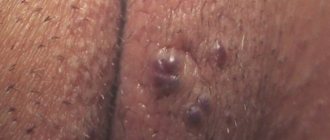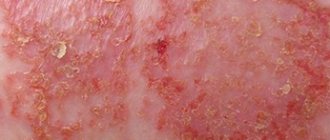Herpetic infections of the perianal skin and rectum are identified as a separate nosological form (ICD-10 code A60.1).
The disease can occur in focal or diffuse form.
With focal herpes in the anus, it is accompanied by the formation of blisters - the same as on any other parts of the body.
The diffuse form is manifested by a general inflammatory process.
Anal lesions occur in both men and women.
Although it is a sexually transmitted infection, the appearance of a rash in the anus of a male patient does not necessarily indicate a non-traditional sexual orientation.
Anal herpes can be primary or secondary.
Primary initially develops in this area.
It can be combined with genital lesions.
Secondary occurs after the inflammatory process of other localizations as a result of the spread of infection.
Causes of herpes in the anus
Herpes develops as a result of infection from a sexual partner.
The infection is not highly contagious.
The risk of infection from one contact is low.
Therefore, infection is usually caused not by casual relationships, but by long-term sexual relationships between partners.
Herpes is an infection that is not only unpleasant, but also very dangerous.
According to WHO, it causes 15% of deaths from viral infections.
According to this indicator, it is second only to influenza (35%).
But it is worth noting that people do not die from genital herpes.
They die only from herpetic encephalitis and disseminated forms, which develop only in children or patients with immunodeficiencies (including HIV).
The mere fact of infection with herpes is not enough to cause an inflammatory process in the anus or other localization.
Antibodies to the herpes virus are detected in 80% of the adult population.
This suggests that most people encounter this pathogen.
But only in isolated cases do clinically manifest forms of the disease develop.
Of all the people who have antibodies detected in their blood:
- 70% have never suffered from herpes symptoms
- only 5% have viral shedding at the time of the study, determined by PCR
- minimally expressed symptoms that do not cause discomfort are detected in 10% of people
- only 15% of cases are manifest forms of the disease
Thus, 85% of people infected with herpes do not suffer from this disease at all and do not even know about it.
But 15% of people experience severe symptoms.
How does infection occur?
The main method of transmission of the pathogen from the carrier is airborne droplets. It is almost impossible to protect yourself from herpes - there is hardly a person willing to be careful for life and limit close contacts. 25 patients out of 100 become new carriers of the infection as a result of unprotected sexual contact.
Herpetic esophagitis affects the mucous membrane of the esophagus, entering the gastrointestinal tract from the pharynx or through generalization. The virus can penetrate the intestinal mucosa through the vagus nerve.
Ways of transmission of herpes
Herpes is transmitted through any contact, most often through sexual contact.
If anal symptoms occur, it may be:
- primary infection
- introduction of infection by the person himself from other foci of his own body
The entry point for infection can be the skin or mucous membrane.
You can become infected during sexual intercourse, even if your partner has no visible rashes on the skin.
The virus is contained in:
- bubbles
- sperm, urine, saliva and other body fluids
- discharge of the genitourinary organs and nasopharynx
Infection occurs through any sexual contact, including genital-oral.
Genital herpes in women: modern aspects of etiology, pathogenesis and clinic
Etiology. Pathogenesis There are two main antigenic groups of HSV: types I and II. Moreover, strains belonging to the same antigenic type may differ in immunogenicity, virulence, resistance to various chemical and physical factors, which ultimately determines the characteristics of the clinical manifestations of the disease. HSV-I strains can often be isolated from lesions of the skin of the face and upper extremities; HSV-II strains can be isolated from genital localization of lesions, although a direct connection between antigenic specificity and the localization of clinical manifestations of herpes is not found.
The source of HSV infection is a patient or a virus carrier. The virus is transmitted by airborne droplets, contact, transfusion and organ transplantation. During pregnancy, infection of the fetus can occur through the transplacental and transcervical (ascending) routes.
It has been established that in 40% of cases, primary HSV infection occurs through airborne droplets in early childhood, and the source of infection, as a rule, is family members with active signs of GI.
The main links in the pathogenesis of HI are:
1. Infection of the sensory ganglia of the autonomic nervous system (ANS) and lifelong persistence of HSV in them.
2. Damage to immunocompetent cells, leading to secondary immunodeficiency.
3. HSV tropism for epithelial and nerve cells, causing polymorphism in the clinical manifestations of GI.
The virus begins to multiply at the site of inoculation - the entrance gate of infection (skin, red border of the lips, mucous membranes of the oral cavity, genitals, conjunctiva), where typical blistering rashes appear, and penetrates the bloodstream and lymphatic system. In the early stages of HI, viral particles also penetrate into the nerve endings of the skin or mucous membrane, move centripetally through the axoplasm, reaching the peripheral, then segmental and regional sensory ganglia of the central nervous system (CNS), where they remain in a latent state in nerve cells for life.
Infection of sensory ganglia is one of the important stages in the pathogenesis of HI. In case of facial herpes, these are the sensitive ganglia of the trigeminal nerve; in case of herpes, these are the ganglia of the lumbosacral spine, which serve as a reservoir of the virus for its sexual transmission. The spread of HSV in a centrifugal direction during a relapse determines the anatomical fixation of lesions in relapses of herpes simplex.
A recurrent course of infection is observed in 30-50% of the population infected with HSV. Recurrent herpes (HH) affects representatives of all age groups.
The progressive course of HSV infection consists of the appearance of more severe clinical symptoms with increasing duration of the disease, as well as the involvement of organs and systems in the infectious process.
Exacerbations of GI can be triggered by hypothermia, insolation, physical or mental trauma, alcohol intake, and hormonal cycles.
The frequency and intensity of exacerbations during WG vary widely and depend on the virulence and pathogenicity of the pathogen, as well as the resistance of the human body. The disease most often occurs as a local process, the rashes are usually limited in nature.
Herpes simplex can occur in local and widespread forms; the latter is less common and is characterized by the simultaneous appearance of several lesions in distant areas of the skin and mucous membrane or the involvement of tissues adjacent to the lesion in the pathological process.
The appearance in patients during relapses, along with herpetic rashes, of symptoms of intoxication caused by viremia (general weakness, malaise, low-grade body temperature, enlarged and painful peripheral lymph nodes), indicate dissemination of the infectious process, the inability of the immune system to localize the process.
Recurrent forms of herpes have a negative effect on the patient's immune system. HSV, which develops in immunocompetent blood cells, leads to secondary immunodeficiency, which is clinically manifested in frequent colds, decreased performance, the appearance of low-grade body temperature, lymphadenopathy, and psychoasthenia. Recurrent genital herpes (RGH), disrupting the normal sex life of patients, often causes neuropsychiatric disorders and leads to family troubles.
Viremia in women during pregnancy can cause fetal death and stillbirth: herpes viruses cause up to 30% of spontaneous abortions in early pregnancy and over 50% of late miscarriages; they are second only to the rubella virus in terms of teratogenicity.
To date, evidence has been obtained that HSV is often an etiological factor in inflammatory diseases of the central nervous system (meningoecephalitis, ganglioneuritis), ear, nose and throat, lungs (chronic bronchitis), cardiovascular system (peri- and myocarditis, possibly coronary heart disease), gastrointestinal tract, genitourinary system. Damage to the skin and mucous membranes is the most common clinical manifestation of GI, and HSV lesions of the genitals are one of the most common sexually transmitted diseases.
Genital Herpes Clinic (GG)
According to the existing international classification, primary and recurrent HH are distinguished; the latter, in turn, is divided into typical and atypical clinical forms and asymptomatic viral shedding.
The term “genital herpes” implies the presence of a lesion on the skin and mucous membranes of the external genitalia. With the development of virological research methods, information began to appear about asymptomatic and atypical forms of the disease. The diagnosis of “asymptomatic form of GG” is made based on the results of a virological examination when HSV is isolated from the discharge of the urogenital tract, while there are no symptoms of skin lesions and visible mucous membranes of the genitals.
The diagnosis of “atypical form of GG” is made by gynecologists to designate a chronic inflammatory process of the internal genitalia (colpitis, vulvovaginitis, endocervicitis, etc.) in the presence of a laboratory confirmed herpetic nature of the disease, in contrast to the “typical” picture of the disease, in which the mucous membrane of these organs There are lesions with vesicular-erosive elements. At the same time, herpetic lesions of the urethra, anal area and rectal ampulla fall out of this group, although these organs are anatomically and functionally closely related to the genital area.
Infection of the genitals in adults usually occurs as a result of sexual intercourse. The highest incidence of HS was registered in the age group of 20-29 years. Individuals who begin sexual activity at an early age and have many sexual partners are at increased risk of developing HS.
Clinical manifestations of HH are more pronounced in seronegative individuals than in seropositive individuals, which indicates the influence of the immune response formed to HSV-I in childhood on the severity of clinical manifestations of herpes during infection of the genitals with HSV-II.
In most cases, primary infection of the genitals is asymptomatic, subsequently turning into latent carriage of the herpes virus or into a recurrent form of HH. However, in cases of clinically significant onset, primary HH usually manifests itself after a 1-10-day incubation period and differs from subsequent relapses in its more severe and prolonged course.
The typical clinical picture of primary HS is characterized by the appearance of grouped vesicular elements on the mucous membranes of the genital organs and adjacent areas of the skin, appearing on an erythematous background. After 2-4 days, the vesicles open, forming weeping erosions, less often - ulcers, epithelializing under the crust or without its formation. Subjectively, patients are bothered by itching, burning, and pain in the affected area. Some experience an increase in body temperature up to 38°C, and a painful enlargement of the inguinal lymph nodes. The duration of the acute period in primary HS can reach 3-5 weeks.
RGG is one of the most common infectious diseases of the genitourinary system. The disease is difficult to treat and is characterized by a chronic course and impaired sexual function of the patient, which often leads to the development of neurasthenia. In women, herpetic rashes can appear on the labia majora and minora, vaginal mucosa, cervix, perineum and anal area, and the skin of the buttocks and thighs is often affected. The disease is accompanied by the appearance and development of symptoms of intoxication (low-grade fever, general weakness and malaise), enlargement and tenderness of the inguinal lymph nodes (usually on one side).
RGG is characterized by early opening of vesicles with the formation of erosive surfaces and pronounced subjective symptoms (pain, itching, burning sensation in the lesion). RGG is characterized by a severe course; often relapsing forms of the disease occur in 50-75% of patients.
The typical form of RG of the external genitalia is characterized by pronounced symptoms of the disease, the classic development of the lesion (erythema, formation of vesicles, development of erosive-ulcerative elements, epithelization) and subjective sensations, manifested by repeated blistering rashes. The lesions are usually limited, less common and localized in the same area of the skin or mucous membrane. Frequent exacerbations of RGG are often accompanied by a disturbance in the general condition of patients. Within 12-48 hours, local and general prodromal phenomena may appear: itching, burning sensation, pain in the areas of future rashes, regional lymphadenitis, symptoms of intoxication caused by viremia.
The presence of vesicular or erosive rashes on the skin and mucous membrane of the genitals, severe subjective symptoms (itching, burning) allow doctors to visually diagnose RGG, promptly prescribe treatment and inform the patient about the infectious nature of the disease and the danger of infecting a sexual partner.
It should be noted that under the influence of the therapy, the typical course of RGG can change significantly and become abortive. In this case, the elements in the lesion site bypass individual stages of development. In these cases, the lesion may be represented by a papular element, microerosion, or an edematous spot on an erythematous background. Help in making a diagnosis when treating a patient with abortive RH can be provided by a correctly collected anamnesis, which indicates that the patient has had rashes typical of herpes in the past.
Atypical forms of RGG, which significantly complicate the diagnosis, are due to a number of factors:
1) a change in the development cycle of herpetic elements in the lesion;
2) unusual localization of the lesion and anatomical features of the underlying tissues;
3) the predominance of subjective sensations in the lesion
In atypical forms of RHH, one of the stages of development of the inflammatory process in the lesion (erythema, blistering), or one of the components of inflammation (edema, hemorrhage, necrosis), or subjective symptoms (itching) predominates, which give the corresponding name to the atypical form RHH (erythematous, bullous, hemorrhagic, necrotic, itchy). According to the intensity of clinical manifestations, atypical forms can occur rapidly as manifest (bullous, ulcerative-necrotic) or as subclinical (microcracks). And if in atypical forms of RGG, manifested by the formation of vesicles and erosions, into which blisters and ulcers can be transformed with the addition, for example, of a necrotic component, GG can be suspected, then in clinical forms that are not accompanied by a violation of the skin and mucous membrane or the lesion has an unusual form, the diagnosis is established with great difficulty.
Atypical forms of herpes of the external genitalia are more common in women than in men.
In the edematous form of RGG, the lesion on the vulvar mucosa is represented by hyperemia and diffuse edema.
The “itchy” form of RGG is characterized by periodic local appearance of severe itching and (or) burning in the area of the external genitalia with slight hyperemia of the vulvar mucosa at the site.
Atypical forms of RGG also include HSV infection, manifested by single deep recurrent cracks in the mucous membrane and underlying tissues of the labia minora and majora, accompanied by severe pain.
The subclinical (asymptomatic) form of RGG is manifested by microsymptoms: short-term (less than a day) appearance of one or more microcracks, accompanied by slight itching. Sometimes there are no subjective sensations, which reduces the number of patients visiting medical institutions and complicates diagnosis. The subclinical form is usually detected during a virological examination of sexual partners of patients with any sexually transmitted disease, or during an examination of married couples with impaired fertility.
Clinical diagnosis of abortive course, atypical and subclinical forms of RGG is difficult and can only be made using virological research methods.
In the epidemiological aspect, it is these clinical forms of genital herpes that are the most dangerous for the spread of GI, when, against the background of minimal clinical manifestations of the disease, HSV is released into the environment, and the absence of severe symptoms allows patients to have an active sex life and infect sexual partners.
A feature of GG of the female genital organs is multifocality. The pathological process often involves the lower part of the urethra, the mucous membrane of the anus and rectum. Involvement of these organs in the infectious process may occur secondarily following the onset of herpes of the external genitalia, or may occur as an isolated lesion.
Herpetic infection of the pelvic organs.
Based on the characteristics of clinical manifestations, it is advisable to divide herpetic lesions of the pelvic organs into:
1) herpes of the lower part of the urogenital tract, anal area and rectal ampulla;
2) herpes of the upper genital tract.
Herpes of the anal area and ampulla of the rectum, lower part of the urogenital tract (damage to the mucous membranes of the entrance to the vagina, vagina, vaginal part of the cervix, cervical canal, urethra, bladder) manifests itself in two clinical forms: focal, characterized by the appearance of mucous membranes typical of herpes simplex membranes of vesicular-erosive elements, and diffuse, in which the pathological process proceeds as a nonspecific inflammation.
Herpes of the urethra and bladder. Herpetic urethritis is subjectively manifested by pain and cramping at the beginning of urination, dysuric phenomena. On examination, hyperemia of the external urethral opening and scanty mucous discharge are observed; With urethroscopy in the anterior part of the urethra, it is sometimes possible to detect small superficial erosions and catarrhal inflammation. The leading symptoms of herpetic cystitis are cystalgia, the appearance of pain at the end of urination, and dysuric phenomena.
Herpes of the anal area and rectum. The lesion in the anal area usually represents a recurrent fissure, which is often a reason for diagnostic errors. Such patients with an erroneous diagnosis of “anal fissure” end up with surgeons. The itchy form of herpes anus and herpetic lesions of hemorrhoids are also difficult to diagnose.
Damage to the anal area can occur primarily as an independent disease or secondarily as a result of leakage of vaginal discharge and maceration of the anal mucosa if the patient has herpetic colpitis, accompanied by heavy exudation.
When the sphincter and mucous membrane of the rectal ampulla are damaged (herpetic proctitis), patients are bothered by itching, burning sensation and pain in the affected area, small erosions occur in the form of superficial cracks with a fixed localization, bleeding during defecation. Rectoscopy reveals catarrhal inflammation and sometimes erosion.
Diagnosing herpetic proctitis can be especially difficult. We observed patients with RG of the anal area, in whom the onset of the disease was associated with the periodic appearance of scanty mucous, sometimes sanguineous, discharge from the rectum, which coincided in time with sharp bursting pain in the sigmoid region and flatulence, accompanied by severe itching in the anal area. Subsequently, these patients began to develop bleeding fissures in the anal area. Based on the data of retro- and colonoscopy (in some cases with a biopsy) and the results of a virological examination, these patients were diagnosed with “herpetic proctitis”, “RH of the anal area”.
Herpes of the upper genital tract (damage to the uterus, fallopian tubes). The typical clinical picture of herpetic lesions of the upper genitourinary tract is manifested by symptoms of nonspecific inflammation. Typically, patients complain of vaginal discharge, periodic pain in the pelvis, area of the uterus, and ovaries. These patients have been treated by gynecologists with antibacterial and antifungal drugs for a long time without effect. At the same time, a significant number of women who have no discharge and subjective symptoms do not go to the doctor at all and remain a source of infection for a long time.
Such diagnoses as “HSV endometritis” and “HSV salpingoophoritis” are practically never made by doctors. At the same time, ascending forms of herpetic lesions of the internal genital organs in women are confirmed by the detection of HSV in the endometrium, fallopian tubes and uterosacral ligaments. It is very difficult to establish the real frequency of damage to the internal genital organs, because In 25-40%, and according to some data, up to 60% of women, the disease is asymptomatic. It can be assumed that this pathology occurs much more often than it is diagnosed.
For the subclinical form of herpes of the internal genitalia, the patient typically has no complaints; sometimes there are indications of periodically appearing light mucous discharge from the vagina. During a gynecological examination, symptoms of inflammation are not detected. During a dynamic laboratory study of smears of the discharge canal of the cervix, vagina and urethra, an increased number of leukocytes is periodically detected (up to 200-250 or more in the field of view), indicating the presence of an inflammatory process. During a virological examination of smears, the HSV antigen is determined in leukocytes using the immunofluorescence method.
The asymptomatic form of herpes of the internal genitalia is characterized by the absence in patients of any complaints about the genital area, objective clinical data confirming inflammation. During a laboratory examination of the discharge of the urogenital tract, HSV is isolated, while in smears there are no signs of inflammation (leukocytosis). The asymptomatic form of herpes of the internal genitalia is detected in 20-40% of women suffering from herpes of the buttocks and thighs. This important circumstance must be taken into account when planning pregnancy in women with this form of GC due to the existing likelihood of developing complications of HSV infection during pregnancy.
Complications of genital herpes.
Every fourth patient suffering from RGG develops complicated forms of the disease. Complications can be local and systemic. Local complications of HS include a complex of symptoms consisting of increased trauma, dryness and the formation of painful bleeding cracks on the mucous membranes of the external genitalia, which occur as a result of mechanical irritation. These symptoms appear several years after the onset of the disease and complicate the sex life of patients. The area of the posterior commissure and the mucous membrane of the vaginal opening are most often affected.
Involvement of the nervous system in the infectious process occurs in every third patient suffering from HSV, which is due to the neurotropism of HSV and the fact that it is the ganglia of the ANS that are the depot of HSV in the human body. It should be noted that pain syndrome with RGG occupies a special place. Noteworthy is the frequent lack of objective data during gynecological examination indicating inflammation of the internal genital organs. In this case, patients complain of periodically arising nagging pain in the lower abdomen, in the area of the projection of the ovaries, radiating to the lumbar region and rectum, pain in the perineum. In some cases, the pain syndrome can imitate the clinical picture of an “acute abdomen.” Long-term pain syndrome causes a decrease in sexual potency and libido in patients.
This phenomenon is usually associated with specific herpetic neuralgia of the pelvic nerve plexus present in patients.
The characteristics of the pain syndrome during RGG are determined by the properties of the nerve formations involved in the infectious process. Irritation of parasympathetic fibers causes subjective sensations in patients in the form of a burning sensation, which is a pathognomonic symptom during relapses of HS. With herpes of the thighs and buttocks, there is often an increase in the superficial pain sensitivity of the skin (hyperesthesia), subjectively perceived by the patient as a tingling sensation, a sensation of “crawling goosebumps”. Clinical manifestations of ganglioradiculitis are manifested by nagging pain along the back of the thigh, which is caused by the involvement of the sciatic nerve in the pathological process.
Diagnosis of herpes
The diagnosis of herpes infection can be made clinically.
But sometimes laboratory confirmation is required.
It is carried out using PCR.
Indications for etiological diagnosis:
- atypical forms of anal herpes
- pregnancy
- signs of dissemination of the process or damage to the central nervous system
- mild symptoms
- infertility or complicated obstetric history
- HIV
- secondary immunodeficiencies
Sometimes herpes resembles other diseases that require differential diagnosis.
PCR helps to distinguish this infection from contact dermatitis, streptoderma, blistering dermatoses and other pathologies that have similar symptoms.
All patients with severe or recurrent herpes require:
- immunogram
- blood test for antibodies to HIV, viral hepatitis
- blood test for antiherpetic antibodies
If complications from the brain are suspected, cerebrospinal fluid is collected and immunoglobulins to the herpes virus are determined in it.
Treatment of herpes in the anal area
Treatment of herpes on the anus is carried out in the same way as treatment of herpes infection of any other location.
The patient is prescribed antiviral drugs.
Specific drugs are used that block the replication of the virus.
They belong to the group of acyclic nucleosides.
Names of drugs:
- acyclovir
- valacyclovir
- famciclovir
Clinical studies have not demonstrated superiority of any of them in the effectiveness of treatment.
Therefore, the differences concern only the secondary properties of these drugs: ease of use, price, etc.
Historically, the first and most studied drug is acyclovir.
But it's not very convenient.
Some schemes involve its use up to 5 times a day.
It is much more convenient to be treated with valacyclovir, since it is used 1-2 times a day.
Acyclovir is the most common antiviral drug.
Therefore, it is produced by different manufacturers and exists in different dosage forms.
Most antiviral drugs are taken orally.
External use is less effective, so it is used only in combination with tablets or capsules.
Parenteral administration is required only for severe forms of herpes infection.
When is antiviral treatment required for anal herpes?
Herpes goes away on its own in most people, even without antiviral medications.
But their purpose is still necessary to:
- get rid of symptoms faster
- reduce the risk of complications
Antiviral drugs must be used if herpes appears in the anus in women during pregnancy, children, people with immunodeficiencies, as well as in the case of complicated forms of the disease.
Most doctors do not question whether a person needs these drugs, but always prescribe them if manifest herpes is diagnosed.
These medications do not harm the body and have virtually no contraindications.
At the same time, they help get rid of the virus faster and reduce the risk of infecting a partner.
These drugs are inexpensive.
Therefore, even if herpes is not severe and does not threaten health, there is no reason to refuse treatment and passively wait for recovery.
Antiviral drugs may be prescribed for treatment:
- situational
- suppressive
The differences are that in the first case the person has symptoms, in the second there are none.
The goals of situational therapy are obvious: they are to quickly overcome an exacerbation and reduce unpleasant symptoms.
It is prescribed as early as possible.
Ideally, a person should have valacyclovir in his home medicine cabinet so that he can start taking it during the prodromal period.
That is, when there are no rashes in the anus yet, but itching, burning and tingling have already appeared.
If treatment is started late, when erosions and crusts have formed, then it will not be very effective.
The goals of using suppressive antiviral treatment in a patient who does not have herpes symptoms are:
- preventing infection of regular sexual partners
- reduction in the frequency and severity of exacerbations
Suppressive treatment is prescribed for frequent, severe exacerbations or immunodeficiency (for example, with HIV or chronic use of immunosuppressants).
Symptoms
Herpes near the anus is very similar in its manifestations to the genital one. With this type of disease the following are observed:
- watery blisters located near the anus;
- severe itching and burning in this area;
- soreness and sensitivity of the skin around the anus.
Anal herpes in women is additionally manifested by increased vaginal discharge.
If the virus affects the rectum, the patient will experience the following symptoms of herpes in the intestines:
- itching and burning inside the intestine;
- pain in the perineum, abdomen and sacrum;
- painful and difficult bowel movements;
- blood in stool.
Additionally, in patients of both sexes, both with perianal and intestinal herpes, the temperature may rise, the inguinal lymph nodes will enlarge, and sleep may be disturbed; they may experience headaches and weakness.
Features of the treatment of recurrent herpes in the anus
More than 2 exacerbations of anal herpes per year indicate impaired immunity.
If herpetic rashes around the anus appear too often, they reduce a person's quality of life.
Sometimes relapses overlap each other.
New elements appear while the old ones have not yet been completely resolved.
This situation requires a special approach to treatment.
Options to solve the problem:
- suppressive treatment with antiviral drugs
- nonspecific immunocorrection
- vaccination
If the cause of decreased immunity is unknown, the patient must be examined.
He donates blood to test for antibodies to HIV.
An immunogram is performed.
Based on its results, the immunologist prescribes treatment to restore immunity.
It may last for several months.
Suppressive therapy with antiviral drugs is indicated for patients with established immunodeficiency and frequent exacerbations.
It can last for years if necessary.
Another option to solve the problem is specific immunization.
During the period of remission, the herpes vaccine is administered three times.
It forms specific immunity.
Due to an increase in antiherpetic antibodies in the blood, exacerbations stop completely or occur much less frequently.
If exacerbations occur, they are less severe and practically do not threaten severe complications.








